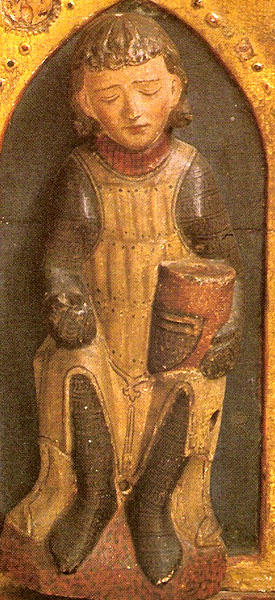
Create an Amazon Wedding Registry
Sleeping Guard from a Reliquary at Wienhausen Monastery, Germany, c.1270AD.



Referenced as Plate 20, in Norman, Vesey. ‘The Medieval Soldier’ 1971
Plate 20 Sleeping guard from a reliquary at Wienhausen, Germany, second half of the thirteenth century. His gown is apparently reinforced by rows of narrow, vertical plates riveted to its inside.
pp. 219-221: In the second half of the thirteenth century, the gown is occasionally represented as if lined with plates, as on the figure of a sleeping guard on a reliquary at Wienhausen in Germany (Plate 20). The position of the plates is indicated by the rivet heads which secure them to the fabric, and often by a suggestion of the outline of the plates showing through the cloth. Nothing like this has been discovered for the early part of the century but very often gowns, clearly made of a soft clinging material, stand stiffly away from the point of the shoulder; as, for instance, on the statues on the front of Wells cathedral (1230-40). The drawing of a kneeling knight by Matthew Paris mentioned above, shows that this may be due to some form of stiff shoulder guard which, in this case, is clearly illustrated beneath the gown, and separate from it (Plate 15). One of the Wells figures, however, has a stiff upstanding collar to his gown, so that it is at least possible that the stiffening of the shoulders is also an integral part of the garment : (Plate 11, page 206).
The characteristic body armour of the first three-quarters of the fourteenth century was the 'coat of plates', sometimes simply called 'plates'. It normally appears in paintings as a short, usually sleeveless, tunic, powdered with small circles or flowers which are, in fact, the large heads of the rivets attaching the overlapping plates inside to their cloth covering. This type is characteristic of north Italian paintings, such as the series of the life of St George by Altichiero in the Chapel of St George, Padua, of about 1380-90. It is not clear when the coat of plates first appears, but tunics powdered with dots and circles, very similar indeed to those in the Altichiero paintings, occur in the work of Matthew Paris and his colleagues about 1250, and also in a Spanish Beatus, Commentary on the Apocalypse of very much the same date or even a little earlier (Paris, Bibl. Nat., Nouv. acq. lat. 2290). In the Beatus manuscript what appear to be nail heads are clearly shown in horizontal rows on the surface of the coat, as well as the vertical seams of the covering material.